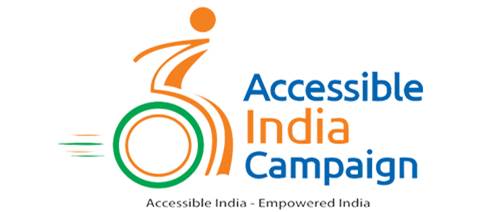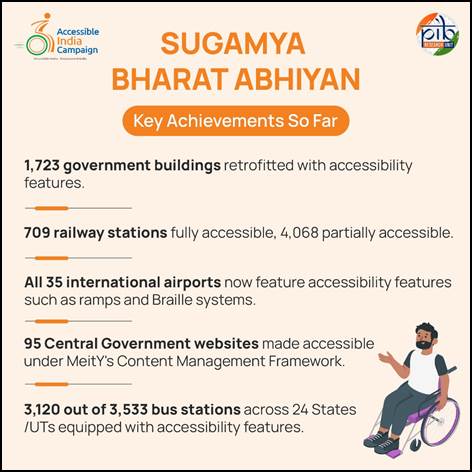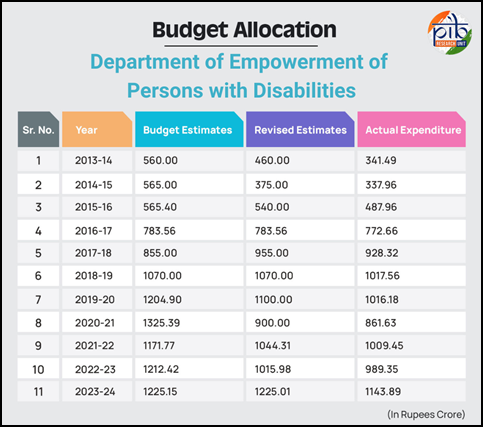Sugamya Bharat Abhiyan
Sugamya Bharat Abhiyan
Introduction
Nine years ago, the Sugamya Bharat Abhiyan, also known as the Accessible India Campaign, embarked on a mission to reshape India into a truly inclusive society. Launched on 3rd December 2015 by the Honourable Prime Minister, this flagship initiative was a direct response to the long-overlooked challenges faced by persons with disabilities. Rooted in the vision of “Sabka Sath, Sabka Vikas, Sabka Vishwas,” the campaign aimed to ensure universal accessibility across three vital domains: built infrastructure, transport systems, and the information and communication technology (ICT) ecosystem.

India, as a signatory to the United Nations Convention on the Rights of Persons with Disabilities (UNCRPD), had committed to creating an accessible environment for persons with disabilities. Yet, prior to 2015, efforts lacked a cohesive strategy or enforceable timelines. The Persons with Disabilities Act of 1995, though welfare-oriented, did not adequately address accessibility issues or empower persons with disabilities to demand their rights. Recognising this gap, the Sugamya Bharat Abhiyan was launched to bring accessibility to the forefront of national development.
The campaign introduced a structured approach, focusing on making public buildings, transport networks like buses and trains, and digital platforms accessible to Divyangjans. It also sought to create awareness and set enforceable standards for accessibility compliance. Although initially planned to conclude by March 2024, the campaign’s objectives have been absorbed into the Creation of Barrier-Free Environment Scheme under the broader umbrella of the Scheme for Implementation of the Rights of Persons with Disabilities Act (SIPDA). This transition reinforces the idea that accessibility is a continuous endeavour, requiring sustained efforts to meet evolving challenges.
As the Sugamya Bharat Abhiyan marks its ninth year, it stands as a milestone in India’s journey towards fulfilling its commitment to an inclusive and equitable society, where every individual can thrive without barriers.
Campaign Achievements
The Accessible India Campaign has achieved significant milestones in creating an inclusive environment for persons with disabilities over the past nine years, with improvements spanning built infrastructure, transportation, digital platforms, education, and media accessibility. From retrofitting thousands of government buildings and transport facilities to developing sign language training and ensuring accessible TV content, the campaign has laid the groundwork for universal accessibility in India.

Here are the key achievements:
Accessible Infrastructure
Transportation
Digital Accessibility
Education and Language Accessibility
Media Accessibility
Other Initiatives and the Way Forward
Sector-Specific Accessibility Guidelines: Efforts are ongoing to finalise accessibility standards for the four remaining identified sectors: Road Transport and Highways, Tourism, Information and Broadcasting, and Financial Services. Currently, 13 out of 20 Central Government Ministries/Departments have notified sector-specific guidelines, while three have adopted guidelines from other departments. Regular follow-ups are underway to expedite notifications.
Web Accessibility: A plan to make 500 additional Government of India websites accessible is in progress. The department, in collaboration with the National Informatics Centre (NIC), is organising training sessions for officers from Central Government Ministries/Departments to ensure compliance with web accessibility standards.
Training of Access Auditors: The Department, in partnership with the Council of Architecture (CoA), has initiated training programs to expand the cadre of certified Access Auditors. The second phase of training for master trainers was conducted in July 2024, raising the total number of access auditors to 59.
Sugamya Bharat App: This crowdsourcing platform empowers individuals to report accessibility issues in infrastructure, transport, and information systems. With features like font adjustments, colour contrast options, and integrated screen readers in Hindi and English, the app is accessible to persons with disabilities. Available in 23 languages, it promotes public participation by enabling users to report issues that are then addressed by relevant authorities.
Curriculum Development: The Department, in collaboration with IIT Kharagpur, is working to introduce specialised courses on accessibility in B. Tech, B. Plan, and B. Arch programs. Stakeholder consultations were held, and recommendations are being reviewed for inclusion in the model curriculum by AICTE.
Technology and Innovation: Basic Indian Sign Language (ISL) training has been provided to over 1,013 airline staff and employees of various public-facing corporate entities. These efforts aim to foster inclusivity in service industries.
Accessible Pilgrimage Sites: A dedicated initiative has been launched to make 75 pilgrimage sites accessible for persons with disabilities (PwDs). Proposals have been received from multiple states, and funds have been allocated to enhance accessibility at locations like Solophek Chardham in Sikkim.
Workshops for Universal Accessibility: A training workshop for State Public Works Department (PWD) officers was conducted from 28th to 31st August 2023, focusing on universal accessibility in built-up environments. The session saw participation from representatives of 14 states and Union Territories, underlining a collaborative approach to accessibility.
Web Accessibility Training Program: In partnership with the National Informatics Centre (NIC), a certified training course on Web Accessibility is being developed. This initiative aims to train approximately 10,000 web developers nationwide and sensitise government departments to adopt and implement Web Accessibility Guidelines. The proposal is currently under review with the Department of Empowerment of Persons with Disabilities (DePwD).
Financial Commitment Towards Empowerment
From 2013-14 to 2023-24, the financial allocations for the Department of Empowerment of Persons with Disabilities have witnessed a significant increase, reflecting the government’s unwavering commitment to inclusivity and accessibility under initiatives like the Sugamya Bharat Abhiyan. Budget Estimates (BE) have progressively risen from ₹560 crore in 2013-14 to ₹1,225.15 crore in 2023-24, with Revised Estimates (RE) and Actual Expenditures (AE) demonstrating alignment with these goals. The ₹1,143.89 crore spent in 2023-24 represents the highest expenditure in a decade, underscoring the government’s focus on achieving universal accessibility and empowerment of persons with disabilities through dedicated campaigns and schemes.

Conclusion
The Sugamya Bharat Abhiyan has emerged as a landmark initiative, driving India’s journey toward a truly inclusive and accessible society. Over the past nine years, it has successfully addressed long-standing challenges faced by persons with disabilities, setting a strong foundation for universal accessibility across infrastructure, transportation, digital platforms, and education. The campaign’s integration into the broader Scheme for Implementation of the Rights of Persons with Disabilities Act (SIPDA) underscores its enduring relevance and the government’s commitment to inclusivity. With sustained efforts, innovative solutions, and increased financial support, the mission to empower every individual to live with dignity and independence remains steadfast, ensuring that no one is left behind in India’s path toward equitable development.
References: